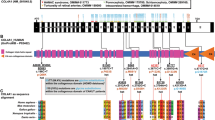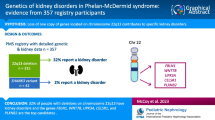Abstract
Background
The DICER1 syndrome is a tumor-predisposition disorder caused by germline pathogenic variation in DICER1 and is associated with cystic nephroma and other renal neoplasms. Dicer1 mouse and rare human DICER1 syndrome case reports describe structural kidney and collecting system anomalies. We investigated renal function and the frequency of structural abnormalities of the kidney and collecting system in individuals with germline loss-of-function variants in DICER1.
Methods
In this family-based cohort study, prospectively ascertained germline DICER1-mutation carriers (DICER1-carriers) and unaffected family controls were evaluated at the National Institutes of Health Clinical Center with renal ultrasound and comprehensive laboratory testing. Two radiologists reviewed the imaging studies from all participants for structural abnormalities, cysts, and tumors.
Results
Eighty-nine DICER1-carriers and 61 family controls were studied. Renal cysts were detected in 1/33 DICER1-carrier children without history of cystic nephroma. Similar proportions of adult DICER1-carriers (8/48; 17%) and controls (11/50; 22%) had ultrasound-detected renal cysts (P = 0.504). 8/89 (9%) DICER1-carriers harbored ultrasound-detected structural abnormalities of varying severity within the collecting system or kidney, nephrolithiasis, or nephrocalcinosis. None of the family controls (0/61) had similar findings on ultrasound (P = 0.02). No meaningful differences in renal laboratory values between DICER1-carriers and unaffected family controls were observed.
Conclusions
Our report is the first to systematically characterize renal function and anatomy in a large prospective cohort of DICER1-carriers and DICER1-negative family controls. DICER1-carriers may be at increased risk of structural anomalies of the kidney or collecting system. The role for DICER1 in renal morphogenesis merits additional investigation.
Similar content being viewed by others
References
Hill DA, Ivanovich J, Priest JR, Gurnett CA, Dehner LP, Desruisseau D, Jarzembowski JA, Wikenheiser-Brokamp KA, Suarez BK, Whelan AJ, Williams G, Bracamontes D, Messinger Y, Goodfellow PJ (2009) DICER1 mutations in familial pleuropulmonary blastoma. Science 325:965
Doros L, Schultz KA, Stewart DR, Bauer AJ, Williams G, Rossi C, Carr A, Yang J, Dehner LP, Messinger Y, Hill DA (2014) DICER1-related disorders. In: Pagon RA (ed) GeneReviews. University of Washington, Seattle (WA). On-line, non-profit, peer-reviewed genetics encyclopedia: https://www.ncbi.nlm.nih.gov/books/NBK196157/
Manivel JC, Priest JR, Watterson J, Steiner M, Woods WG, Wick MR, Dehner LP (1988) Pleuropulmonary blastoma. The so-called pulmonary blastoma of childhood. Cancer 62:1516–1526
Messinger YH, Stewart DR, Priest JR, Williams GM, Harris AK, Schultz KA, Yang J, Doros L, Rosenberg PS, Hill DA, Dehner LP (2015) Pleuropulmonary blastoma: a report on 350 central pathology-confirmed pleuropulmonary blastoma cases by the International Pleuropulmonary Blastoma Registry. Cancer 121:276–285
Schultz KA, Pacheco MC, Yang J, Williams GM, Messinger Y, Hill DA, Dehner LP, Priest JR (2011) Ovarian sex cord-stromal tumors, pleuropulmonary blastoma and DICER1 mutations: a report from the International Pleuropulmonary Blastoma Registry. Gynecol Oncol 122:246–250
Khan NE, Bauer AJ, Schultz KAP, Doros L, Decastro RM, Ling A, Lodish MB, Harney LA, Kase RG, Carr AG, Rossi CT, Field A, Harris AK, Williams GM, Dehner LP, Messinger YH, Hill DA, Stewart DR (2017) Quantification of thyroid cancer and multinodular goiter risk in the DICER1 syndrome: a family-based cohort study. J Clin Endocrinol Metab 102:1614–1622
Stewart DR, Messinger Y, Williams GM, Yang J, Field A, Schultz KA, Harney LA, Doros LA, Dehner LP, Hill DA (2014) Nasal chondromesenchymal hamartomas arise secondary to germline and somatic mutations of DICER1 in the pleuropulmonary blastoma tumor predisposition disorder. Hum Genet 133:1443–1450
Priest JR, Williams GM, Manera R, Jenkinson H, Brundler MA, Davis S, Murray TG, Galliani CA, Dehner LP (2011) Ciliary body medulloepithelioma: four cases associated with pleuropulmonary blastoma--a report from the International Pleuropulmonary Blastoma Registry. Br J Ophthalmol 95:1001–1005
Boman F, Hill DA, Williams GM, Chauvenet A, Fournet JC, Soglio DB, Messinger Y, Priest JR (2006) Familial association of pleuropulmonary blastoma with cystic nephroma and other renal tumors: a report from the International Pleuropulmonary Blastoma Registry. J Pediatr 149:850–854
Doros LA, Rossi CT, Yang J, Field A, Williams GM, Messinger Y, Cajaiba MM, Perlman EJ, Schultz KA, Cathro HP, Legallo RD, LaFortune KA, Chikwava KR, Faria P, Geller JI, Dome JS, Mullen EA, Gratias EJ, Dehner LP, Hill DA (2014) DICER1 mutations in childhood cystic nephroma and its relationship to DICER1-renal sarcoma. Mod Pathol 27:1267–1280
Kim J, Field A, Schultz KAP, Hill DA, Stewart DR (2017) The prevalence of DICER1 pathogenic variation in population databases. Int J Cancer 141:2030–2036
Brenneman MA, Field A, Yang J, Williams G, Doros L, Rossi CT, Schultz KA, Rosenberg A, Ivanovich J, Turner J, Gordish-Dressman H, Stewart DR, Yu W, Harris A, Schoettler P, Goodfellow PJ, Dehner L, Messinger Y, Hill DA (2015) Temporal order of RNase IIIb and loss-of-function mutations during development determines phenotype in DICER1 syndrome: a unique variant of the two-hit tumor suppression model. F1000 Res 4:214
Klein S, Lee H, Ghahremani S, Kempert P, Ischander M, Teitell MA, Nelson SF, Martinez-Agosto JA (2014) Expanding the phenotype of mutations in DICER1: mosaic missense mutations in the RNase IIIb domain of DICER1 cause GLOW syndrome. J Med Genet 51:294–302
de Kock L, Wang YC, Revil T, Badescu D, Rivera B, Sabbaghian N, Wu M, Weber E, Sandoval C, Hopman SM, Merks JH, van Hagen JM, Bouts AH, Plager DA, Ramasubramanian A, Forsmark L, Doyle KL, Toler T, Callahan J, Engelenberg C, Bouron-Dal Soglio D, Priest JR, Ragoussis J, Foulkes WD (2016) High-sensitivity sequencing reveals multi-organ somatic mosaicism causing DICER1 syndrome. J Med Genet 53:43–52
Bartram MP, Hohne M, Dafinger C, Volker LA, Albersmeyer M, Heiss J, Gobel H, Bronneke H, Burst V, Liebau MC, Benzing T, Schermer B, Muller RU (2013) Conditional loss of kidney microRNAs results in congenital anomalies of the kidney and urinary tract (CAKUT). J Mol Med (Berl) 91:739–748
Pastorelli LM, Wells S, Fray M, Smith A, Hough T, Harfe BD, McManus MT, Smith L, Woolf AS, Cheeseman M, Greenfield A (2009) Genetic analyses reveal a requirement for Dicer1 in the mouse urogenital tract. Mamm Genome 20:140–151
Nagalakshmi VK, Ren Q, Pugh MM, Valerius MT, McMahon AP, Yu J (2011) Dicer regulates the development of nephrogenic and ureteric compartments in the mammalian kidney. Kidney Int 79:317–330
Baskin LS (2017) Congenital uretopelvic junction obstruction. UpToDate, Waltham, MA. On-line, peer-reviewed medical textbook: www.uptodate.com
Termos S, AlKabbani M, Ulinski T, Sanjad S, Kotobi H, Chalard F, Aoun B (2017) Ureteropelvic junction obstruction and parathyroid adenoma: coincidence or link? Case Rep Nephrol. https://doi.org/10.1155/2017/9852912
Wiesel A, Queisser-Luft A, Clementi M, Bianca S, Stoll C, EUROSCAN Study Group (2005) Prenatal detection of congenital renal malformations by fetal ultrasonographic examination: an analysis of 709,030 births in 12 European countries. Eur J Med Genet 48:131–144
Schultz KAP, Williams GM, Kamihara J, Stewart DR, Harris AK, Bauer AJ, Turner J, Shah R, Schneider K, Schneider KW, Carr AG, Harney LA, Baldinger S, Frazier AL, Orbach D, Schneider DT, Malkin D, Dehner LP, Messinger YH, Hill DA (2018) DICER1 and associated conditions: identification of at-risk individuals and recommended surveillance strategies. Clin Cancer Res 24:2251–2261
Ho JJ, Marsden PA (2008) Dicer cuts the kidney. J Am Soc Nephrol 19:2043–2046
McHugh K, Stringer DA, Hebert D, Babiak CA (1991) Simple renal cysts in children: diagnosis and follow-up with US. Radiology 178:383–385
Terada N, Ichioka K, Matsuta Y, Okubo K, Yoshimura K, Arai Y (2002) The natural history of simple renal cysts. J Urol 167:21–23
Mir S, Rapola J, Koskimies O (1983) Renal cysts in pediatric autopsy material. Nephron 33:189–195
Acknowledgments
The authors wish to thank the Pine Tree Apple Tennis Classic and St. Baldrick’s Foundation for their ongoing support of children’s cancer research. The authors also wish to thank the many patients, families, and treating physicians who participate in the NCI DICER1-related Pleuropulmonary Blastoma Cancer Predisposition Syndrome study, the International OTST Registry, and/or the International Pleuropulmonary Blastoma/DICER1 Registry. We thank Rosamma Decastro, CRNP for clinical contributions.
Funding
This work was supported by the Intramural Research Program of the Division of Cancer Epidemiology and Genetics of the National Cancer Institute (NCI), Bethesda, MD. DAH is supported by NCI 2R01CA143167.
Author information
Authors and Affiliations
Corresponding author
Ethics declarations
All participants provided written, informed consent, and the study was approved by the National Cancer Institute’s Institutional Review Board (IRB). In addition, clinical, radiographic, and genetic data on participants enrolled in the International Pleuropulmonary/DICER1 Registry and the International Ovarian and Testicular Stromal Tumor Registry were abstracted and reviewed. Both registries are overseen by the IRB at Children’s Minnesota (protocols 98107, 0909-082, 1111-112). Participants in both registries provided informed, written consent for use of their registry data in the current analysis. The study adhered to the precepts in the Declaration of Helsinki.
Conflict of interest
The authors declare that they have no conflict of interest.
Disclaimer
The content of this publication does not necessarily reflect the views or policies of the Department of Health and Human Services, nor does mention of trade names, commercial products or organizations imply endorsement by the US Government.
Electronic supplementary material
ESM 1
(DOCX 33 kb)
Rights and permissions
About this article
Cite this article
Khan, N.E., Ling, A., Raske, M.E. et al. Structural renal abnormalities in the DICER1 syndrome: a family-based cohort study. Pediatr Nephrol 33, 2281–2288 (2018). https://doi.org/10.1007/s00467-018-4040-1
Received:
Revised:
Accepted:
Published:
Issue Date:
DOI: https://doi.org/10.1007/s00467-018-4040-1




